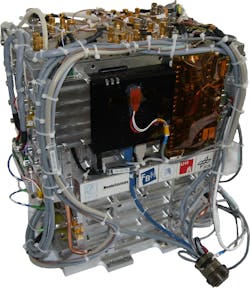Frequency Combs: FOKUS frequency comb launches into space again, compares three clock frequencies

The Faserlaserbasierter Optischer Kammgenerator unter Schwerelosigkeit (FOKUS) instrument from Menlo Systems (Martinsried, Germany) traveled into space on January 23, 2016, aboard the German Space Agencies' (DLR) TEXUS 53 sounding rocket for a second time since the April 2015 inaugural launch of a similar Menlo frequency comb.
Building on the 2015 success in operating a frequency comb in space, this 2016 launch allowed six minutes of experimental time to conduct a comparison of three clock frequencies: two optical clocks using rubidium and potassium atoms, and one radio-frequency (RF) clock based on rubidium atoms.
In addition to measuring optical frequencies with the accuracy of RF atomic clocks, optical frequency combs are also used for ultralow-noise microwave generation, laser frequency referencing of lidar instruments, and high-speed and high-resolution molecular spectroscopy.
FOKUS' anatomy
The upper part of FOKUS contains the analog and digital control electronics, while the lower part includes three optics modules: the pump laser module with pump diodes for the frequency-comb oscillator and optical amplifiers; the frequency-comb module with laser oscillator, optical amplifiers, a nonlinear interferometer for phase stabilization, and beat-detection units for 780 nm; and the 780 nm distributed-feedback (DFB) laser and its saturation-spectroscopy module (see figure).
For the recent launch, an additional amplifier, second-harmonic stage, and mixing optics for beat detection of 767 nm light were added, as well as a more sophisticated 10 MHz reference based on a rubidium clock.
The Menlo optical frequency comb uses a 1.5 μm fiber-laser source and an all-optical-fiber design with telecommunications-grade components. All fibers, couplers, and isolators are polarization-maintaining and embedded in space-proof silicon for improved thermal and mechanical stability. In addition to its femtosecond mode-locked laser source, the comb module includes an erbium-doped fiber amplifier (EDFA) and nonlinear interferometer for carrier-envelope-offset detection, a second-harmonic-generation (SHG) stage, and mixing/filtering optics for 780 nm rubidium and 767 nm potassium laser light.
The rubidium laser module from Humboldt University of Berlin and the Ferdinand Braun Institute comprises a DFB laser and a Doppler-free rubidium spectroscopy module. This miniature spectroscopy module for laser frequency stabilization includes Zerodur-based beamsplitters, mirrors, waveplates, fiber-coupling lenses, a rubidium vapor cell, an electro-optical modulator, and the photodiodes needed to detect a saturation spectroscopy signal and to derive an error signal for frequency stabilization.
A separate potassium stabilized laser module (KALEXUS) was situated on the same TEXUS payload and optically interconnected with FOKUS for the clock comparison.
Frequency comb operation
Essentially a mode-locked laser emitting short optical pulses, the frequency comb has two degrees of freedom: the laser repetition rate and the carrier envelope offset. Offering a train of optical pulses spaced by the inverse repetition rate (10 ns for FOKUS), the individual lines have a well-defined mode distance of 100 MHz.
The comb is phase-stabilized and referenced to a rubidium atomic clock with a 10 MHz clock output. Therefore, the FOKUS optical frequency comb module links the RF domain (kilohertz to a few gigahertz) with the optical domain (hundreds of terahertz). Continuous-wave (CW) laser light from the rubidium- or potassium-stabilized laser are combined with the comb spectrum in the beat-detection units, where the frequency difference between the CW laser line and the next tooth of the comb is detected in a heterodyne beating measurement.
During launch and landing, the comb had to withstand vibrations up to 8 g root-mean-squared (RMS), 15 g shock levels, and constant accelerations up to 13 g while remaining operational. During the micro-g phase, it was automatically brought to a fully phase-locked state and successfully conducted the clock comparison. Its comparison of the three clocks still needs to be evaluated in detail, but is expected to agree with the local position invariance (LPI) to a level of 10-1 to 10-2.
The clock comparisons are a prototype experiment for future satellite-based tests meant to study fundamental physics-specifically, testing Einstein's general theory of relativity (namely the LPI) saying that gravity has the same influence on all clocks, no matter how they are constructed. This successful flight shows the technological maturity of the frequency comb and demonstrates its readiness for operation outside of the metrology lab.
REFERENCE
1. See http://bit.ly/1LEEgiV, from Menlo Systems' website (www.menlosystems.com).
About the Author

Gail Overton
Senior Editor (2004-2020)
Gail has more than 30 years of engineering, marketing, product management, and editorial experience in the photonics and optical communications industry. Before joining the staff at Laser Focus World in 2004, she held many product management and product marketing roles in the fiber-optics industry, most notably at Hughes (El Segundo, CA), GTE Labs (Waltham, MA), Corning (Corning, NY), Photon Kinetics (Beaverton, OR), and Newport Corporation (Irvine, CA). During her marketing career, Gail published articles in WDM Solutions and Sensors magazine and traveled internationally to conduct product and sales training. Gail received her BS degree in physics, with an emphasis in optics, from San Diego State University in San Diego, CA in May 1986.